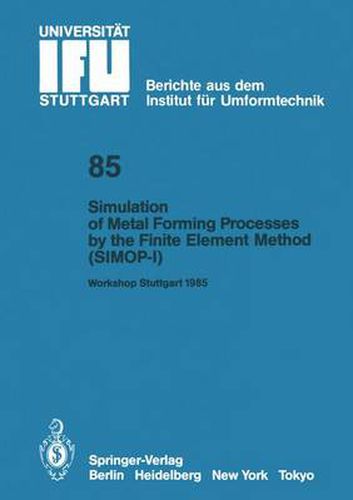Readings Newsletter
Become a Readings Member to make your shopping experience even easier.
Sign in or sign up for free!
You’re not far away from qualifying for FREE standard shipping within Australia
You’ve qualified for FREE standard shipping within Australia
The cart is loading…






This title is printed to order. This book may have been self-published. If so, we cannot guarantee the quality of the content. In the main most books will have gone through the editing process however some may not. We therefore suggest that you be aware of this before ordering this book. If in doubt check either the author or publisher’s details as we are unable to accept any returns unless they are faulty. Please contact us if you have any questions.
The production-costs of formed workpieces are in an increasing extent fixed through the costs for designing and manufacturing the tools. Nowadays, it is possi b 1 e to reduce these redundant tool-costs by app lyi ng modern numeri ca 1 simulation techniques such as the finite element type procedures. In thi s context, the basic ojecti ve of the workshop SUtoP (~imul ation of !:!etal F~rming ~rocesses by the Finite Element Method) was to determine and - especially - to discuss the level of finite-element-simulations of metal-forming processes with regard to technological utilization. On this purpose, eight presentations have been selected to focus the discussions onto the prime aspects such as: - technological aspects (bulk metal forming versus sheet metal forming), - constitutive laws (rigid-plastic versus elastic-plastic versus visko-pl- tic material laws), - coupled analysis (thermo-mechanical coupling), - kinematical description (Eulerian versus Lagrangian formulations, co-ro- tional formulations etc.), - numerical problems (incompressibility, integration of constitutive eq- tions, iterative and incremental schemas, etc.) , as well as - contact problems (friction, heat-transfer, etc.). In order to promote discussions, the audience of the workshop was limited to 50 participants. Due to this fact, we had to refuse unfortunately many app 1 i cat ions. However, we hope that these proceedi ngs - whi ch also inc 1 ude the discussions in an almost complete extent - will be a compensation for those who could not attend the workshop SIMOP-I.
$9.00 standard shipping within Australia
FREE standard shipping within Australia for orders over $100.00
Express & International shipping calculated at checkout
This title is printed to order. This book may have been self-published. If so, we cannot guarantee the quality of the content. In the main most books will have gone through the editing process however some may not. We therefore suggest that you be aware of this before ordering this book. If in doubt check either the author or publisher’s details as we are unable to accept any returns unless they are faulty. Please contact us if you have any questions.
The production-costs of formed workpieces are in an increasing extent fixed through the costs for designing and manufacturing the tools. Nowadays, it is possi b 1 e to reduce these redundant tool-costs by app lyi ng modern numeri ca 1 simulation techniques such as the finite element type procedures. In thi s context, the basic ojecti ve of the workshop SUtoP (~imul ation of !:!etal F~rming ~rocesses by the Finite Element Method) was to determine and - especially - to discuss the level of finite-element-simulations of metal-forming processes with regard to technological utilization. On this purpose, eight presentations have been selected to focus the discussions onto the prime aspects such as: - technological aspects (bulk metal forming versus sheet metal forming), - constitutive laws (rigid-plastic versus elastic-plastic versus visko-pl- tic material laws), - coupled analysis (thermo-mechanical coupling), - kinematical description (Eulerian versus Lagrangian formulations, co-ro- tional formulations etc.), - numerical problems (incompressibility, integration of constitutive eq- tions, iterative and incremental schemas, etc.) , as well as - contact problems (friction, heat-transfer, etc.). In order to promote discussions, the audience of the workshop was limited to 50 participants. Due to this fact, we had to refuse unfortunately many app 1 i cat ions. However, we hope that these proceedi ngs - whi ch also inc 1 ude the discussions in an almost complete extent - will be a compensation for those who could not attend the workshop SIMOP-I.